A Solar Automatic Tracking System that Generates Power for Lighting Greenhouses
Abstract
:1. Introduction
2. Results and Discussion
Solar Tracking System Tests
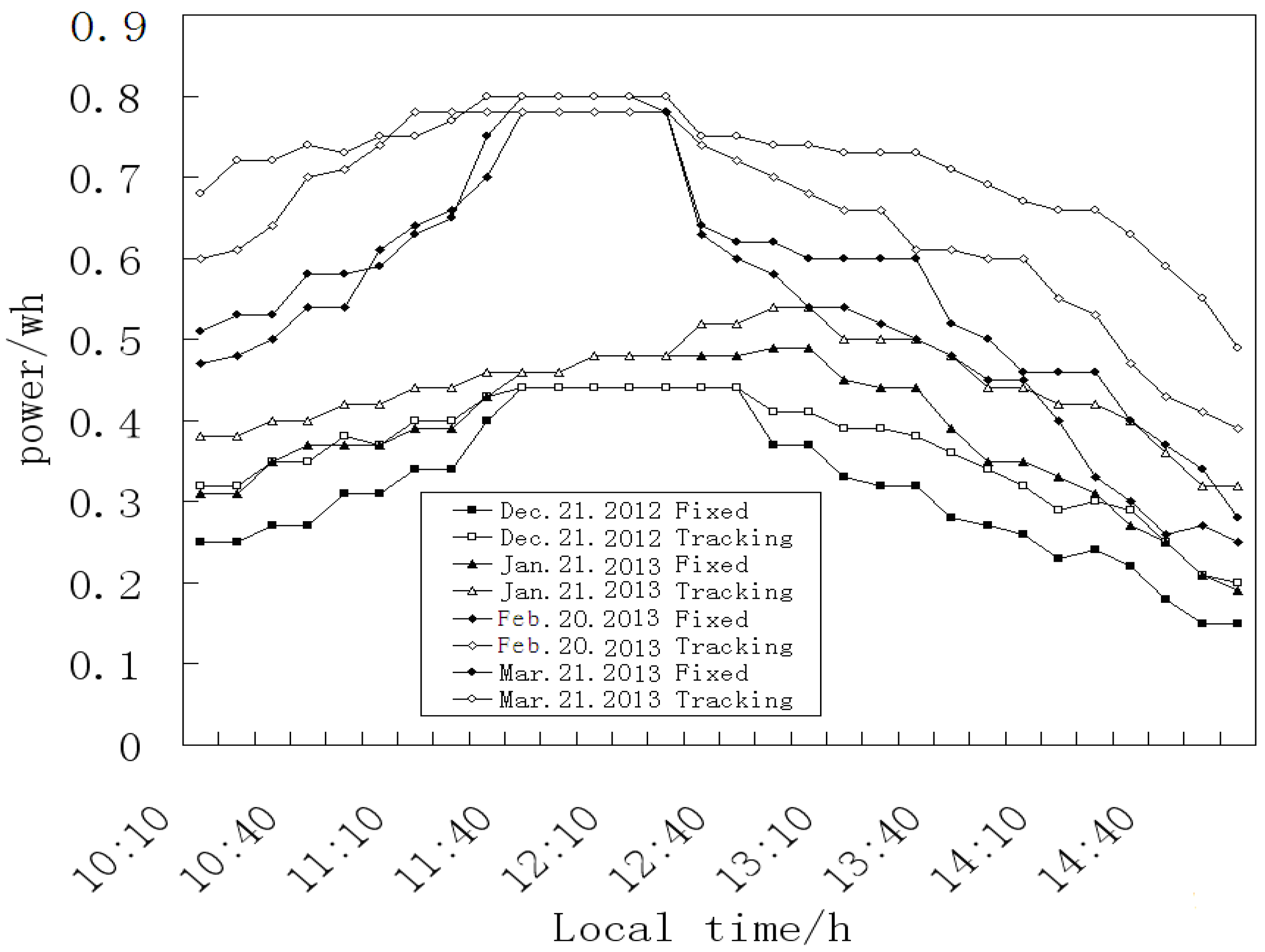
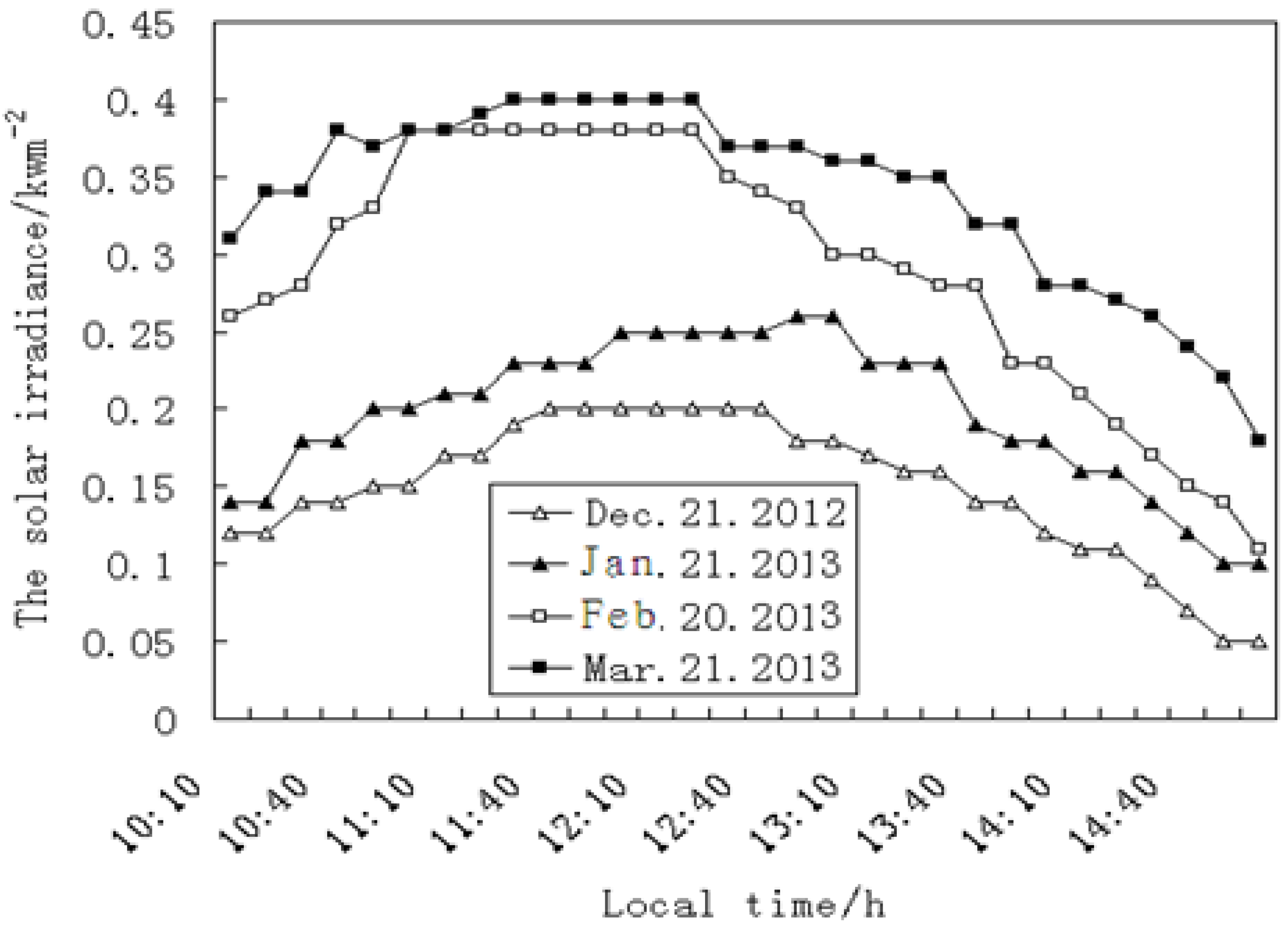
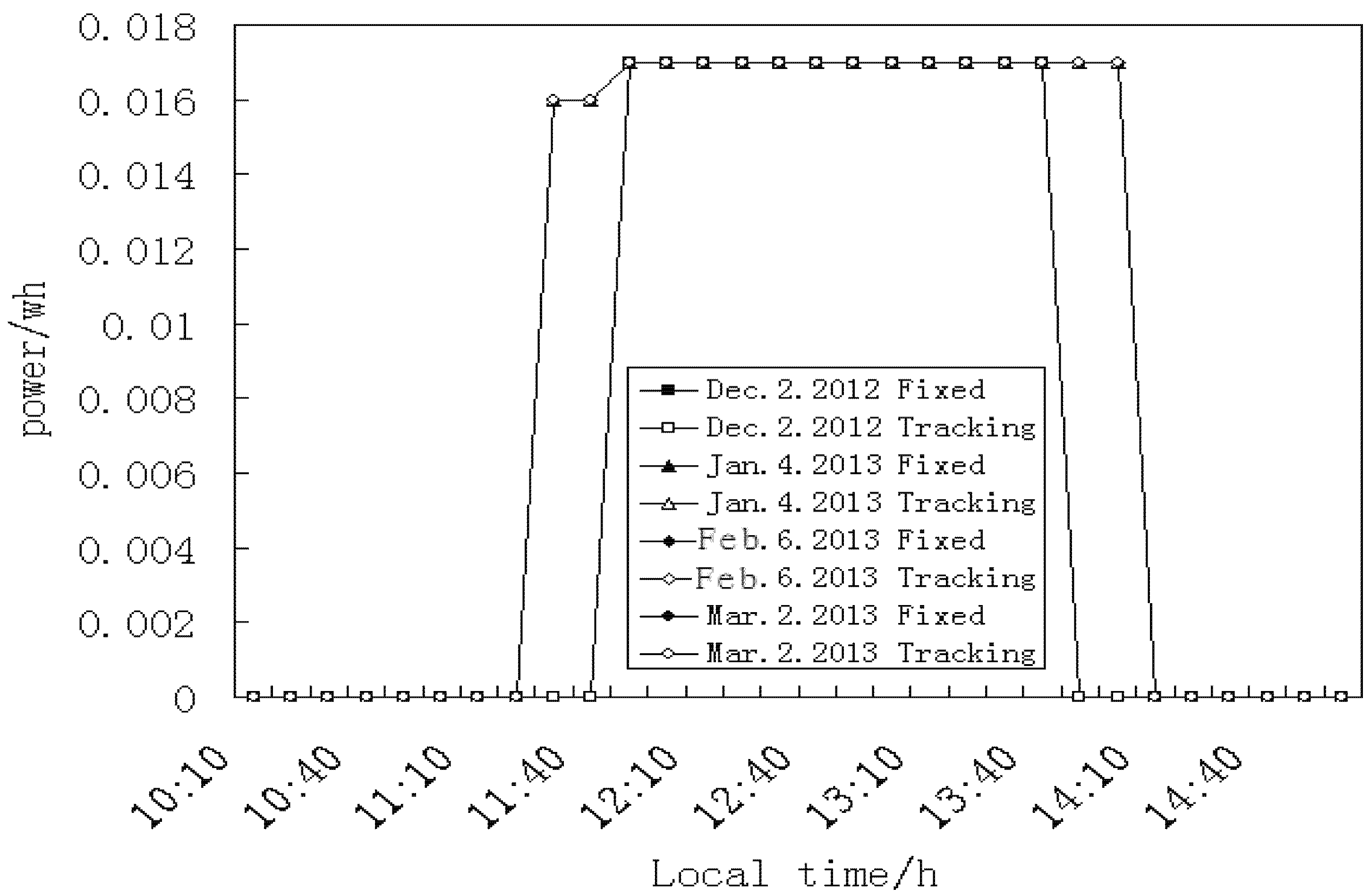
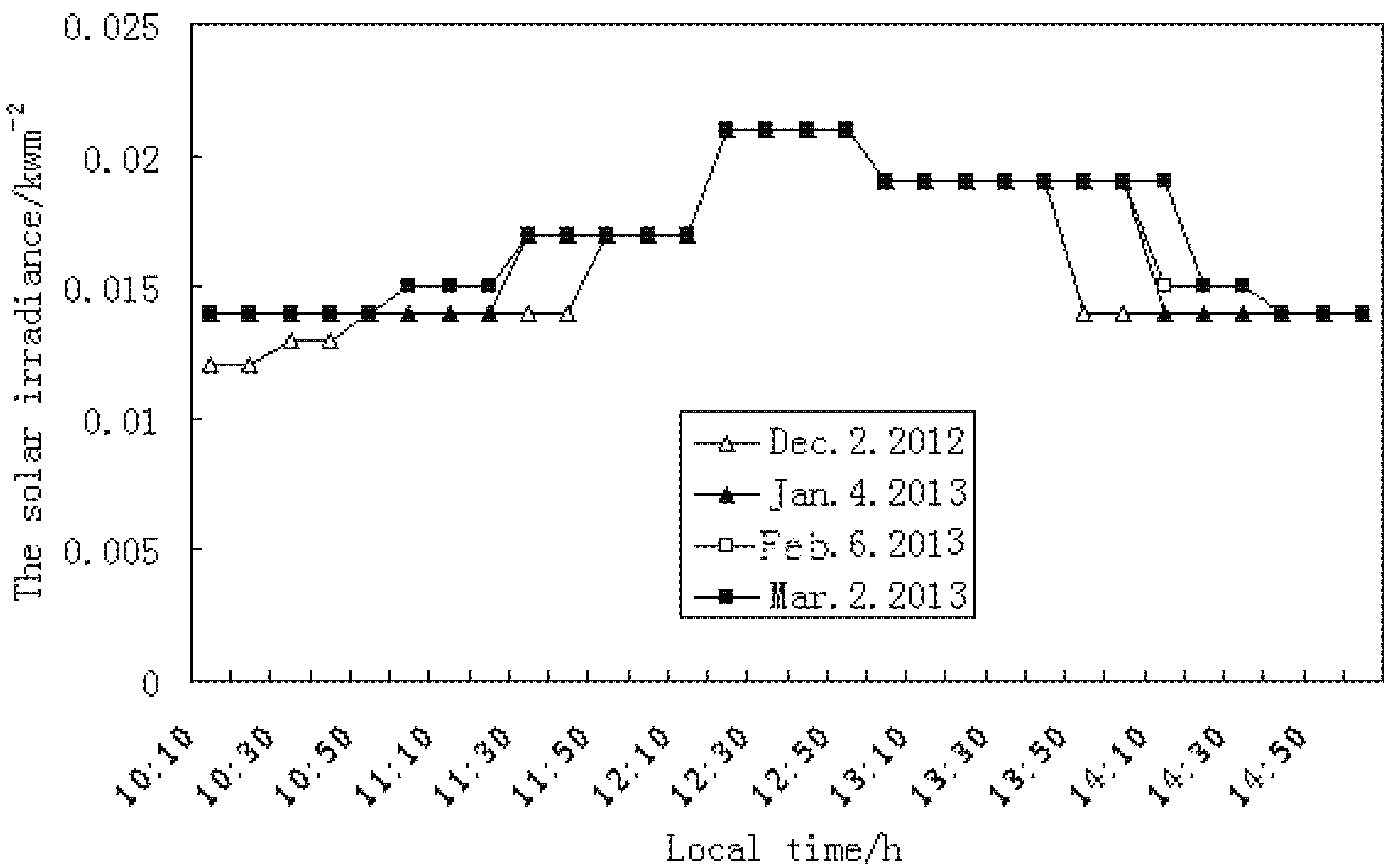
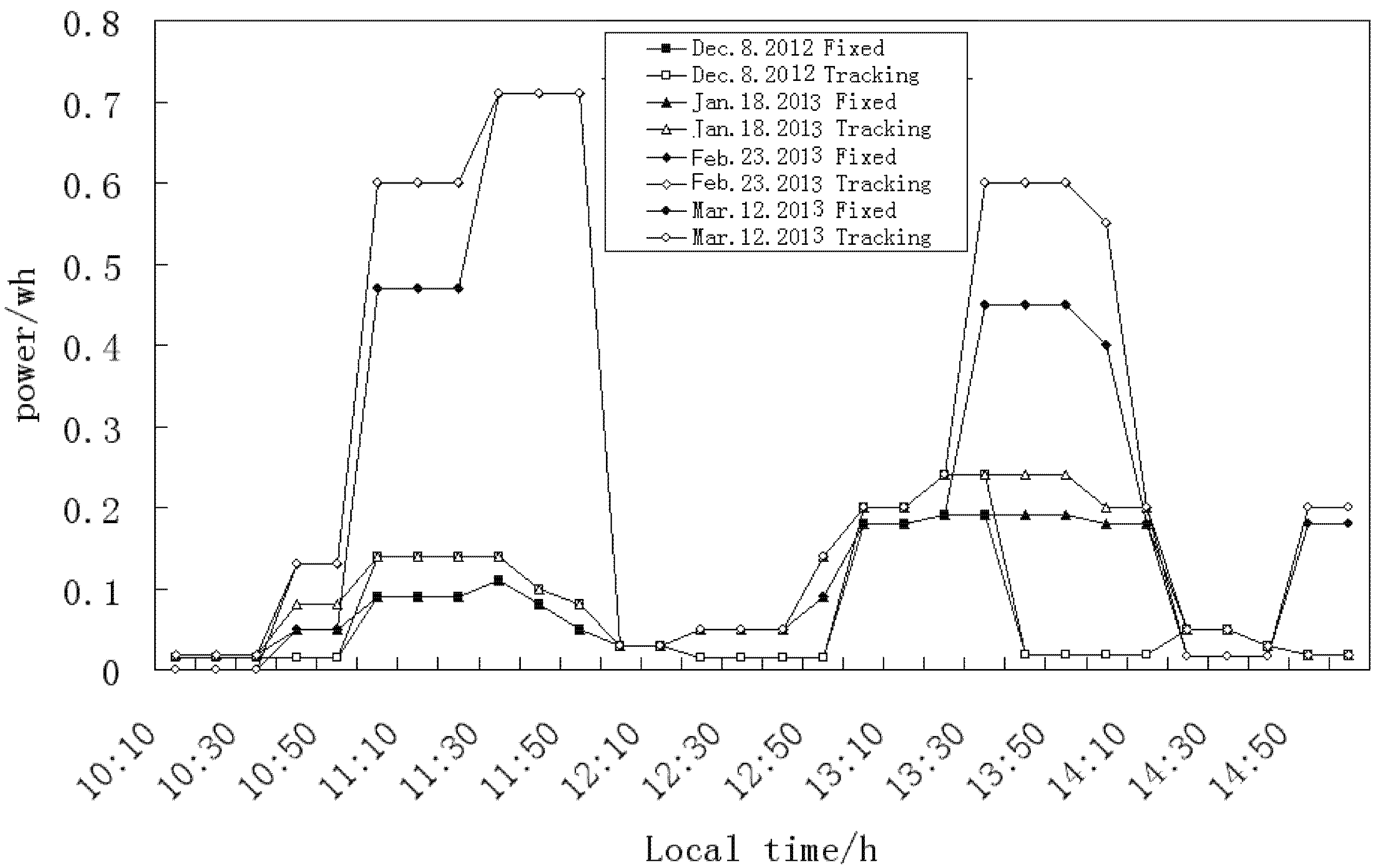
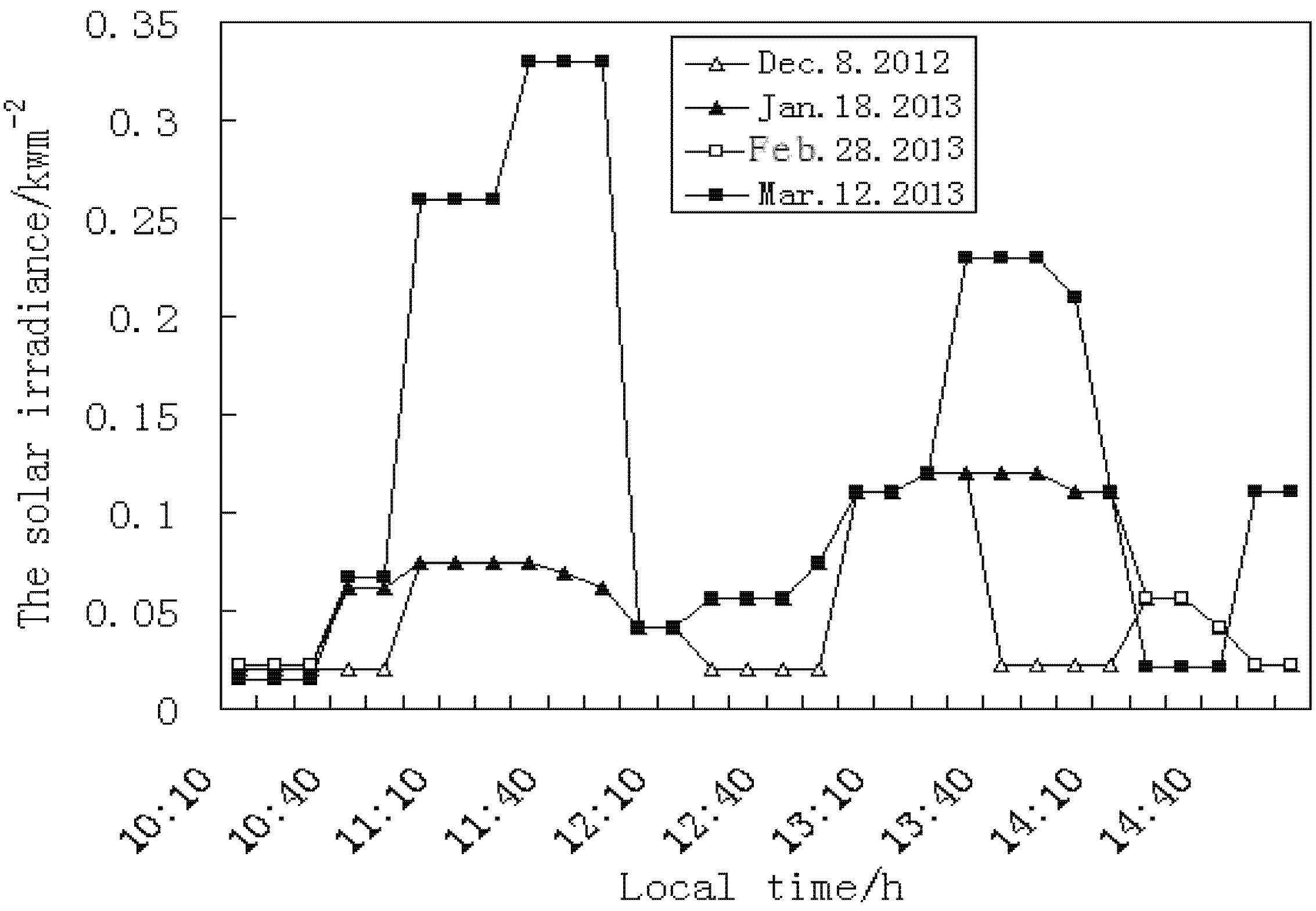
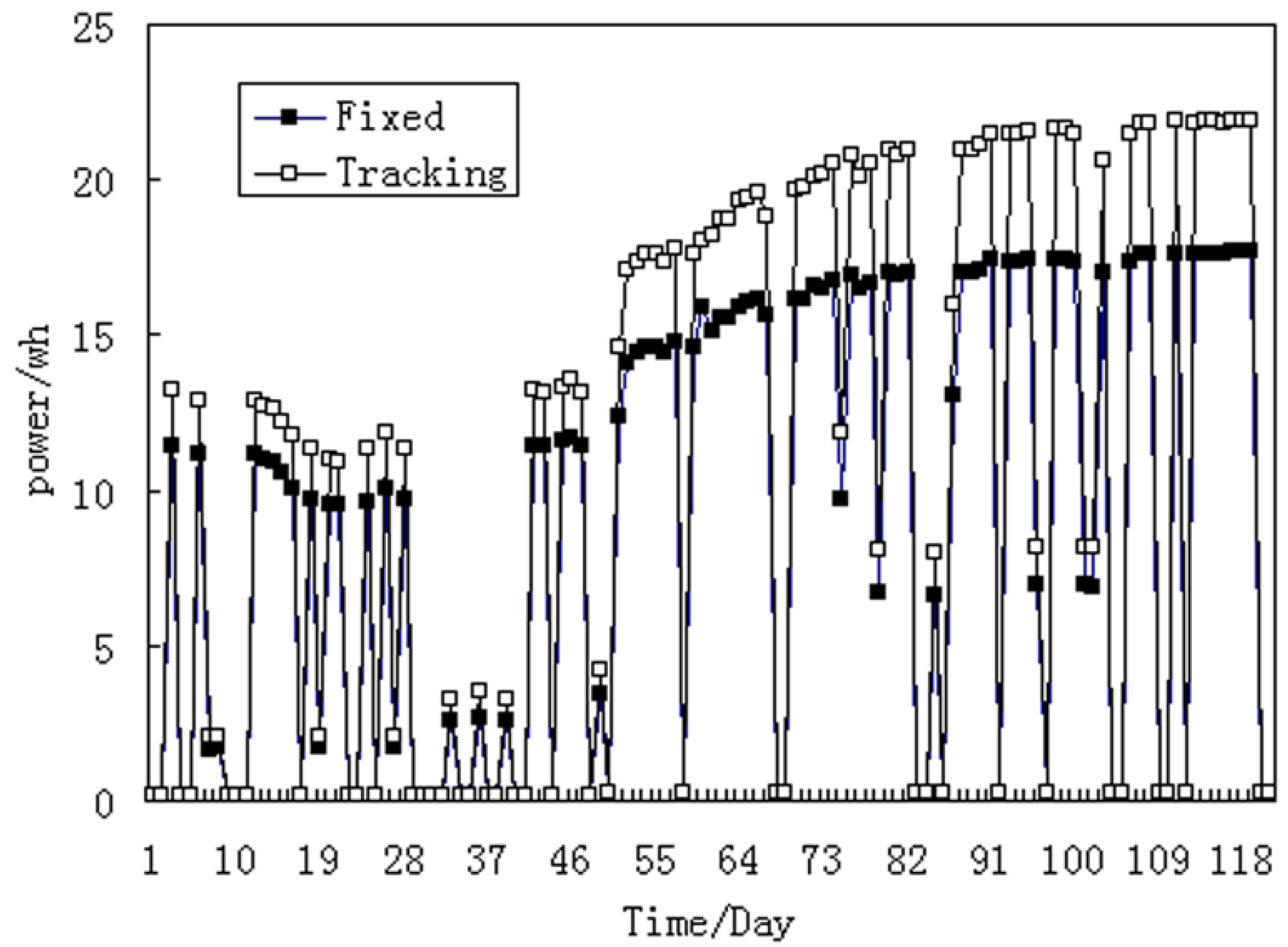
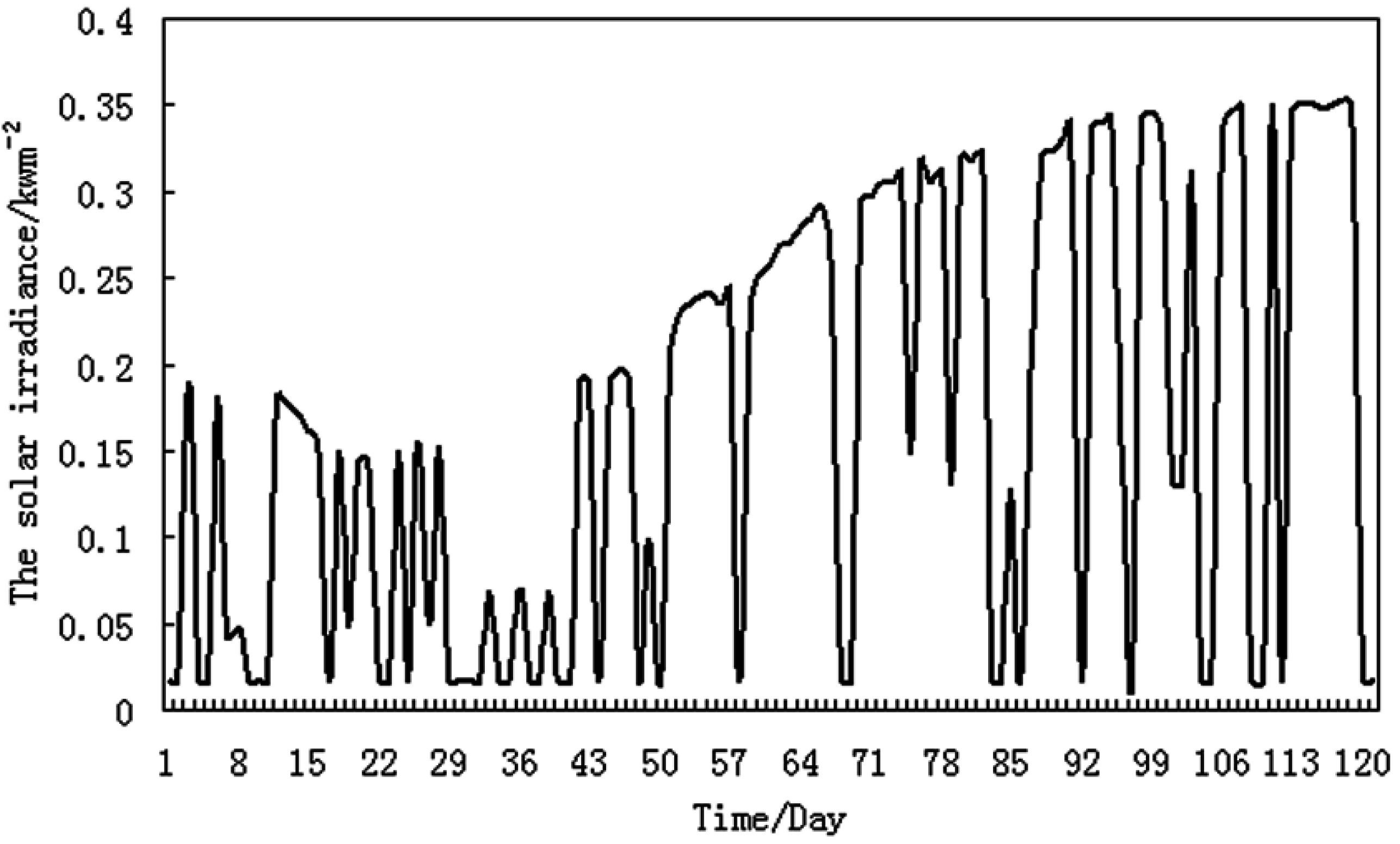

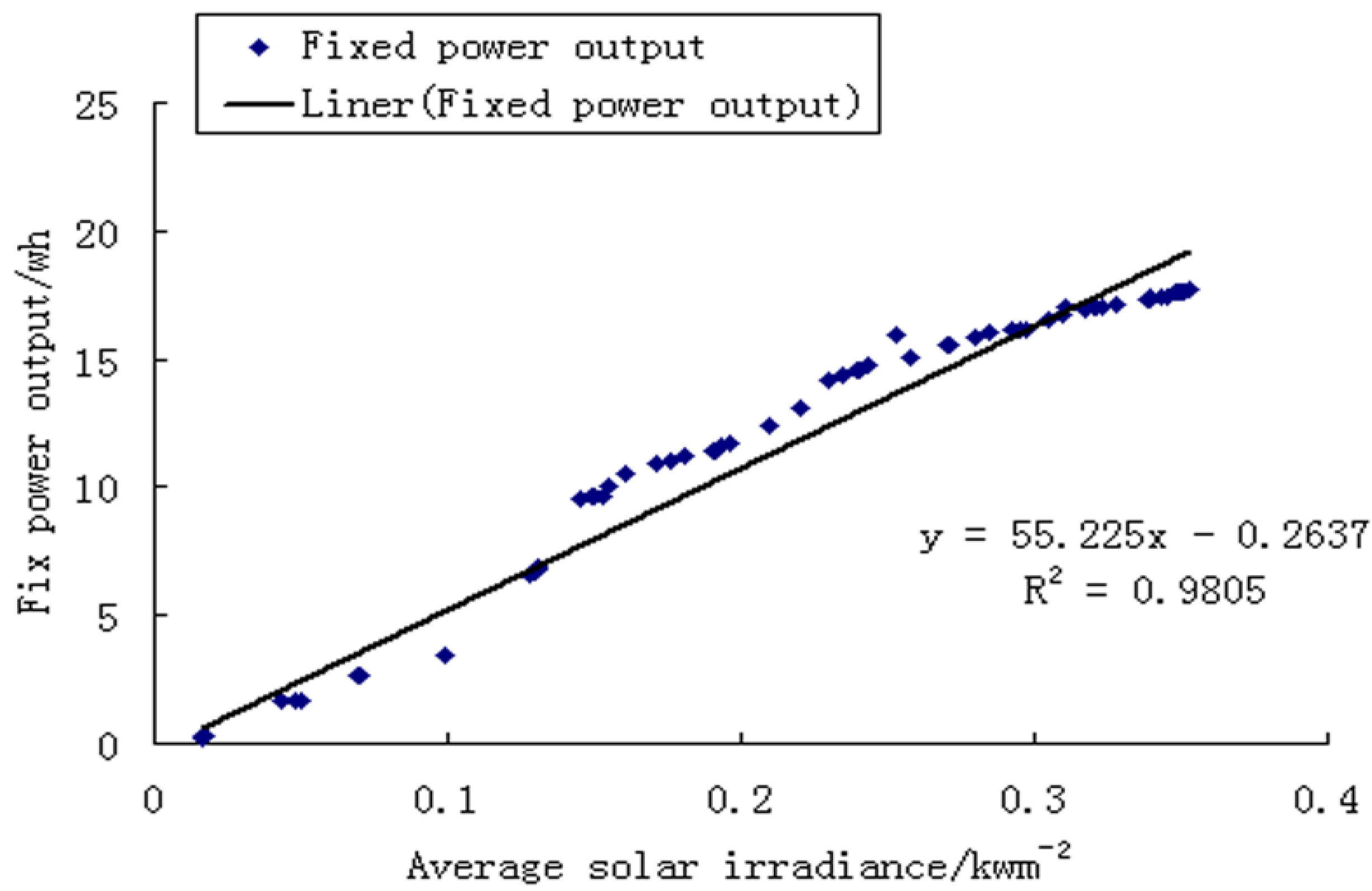
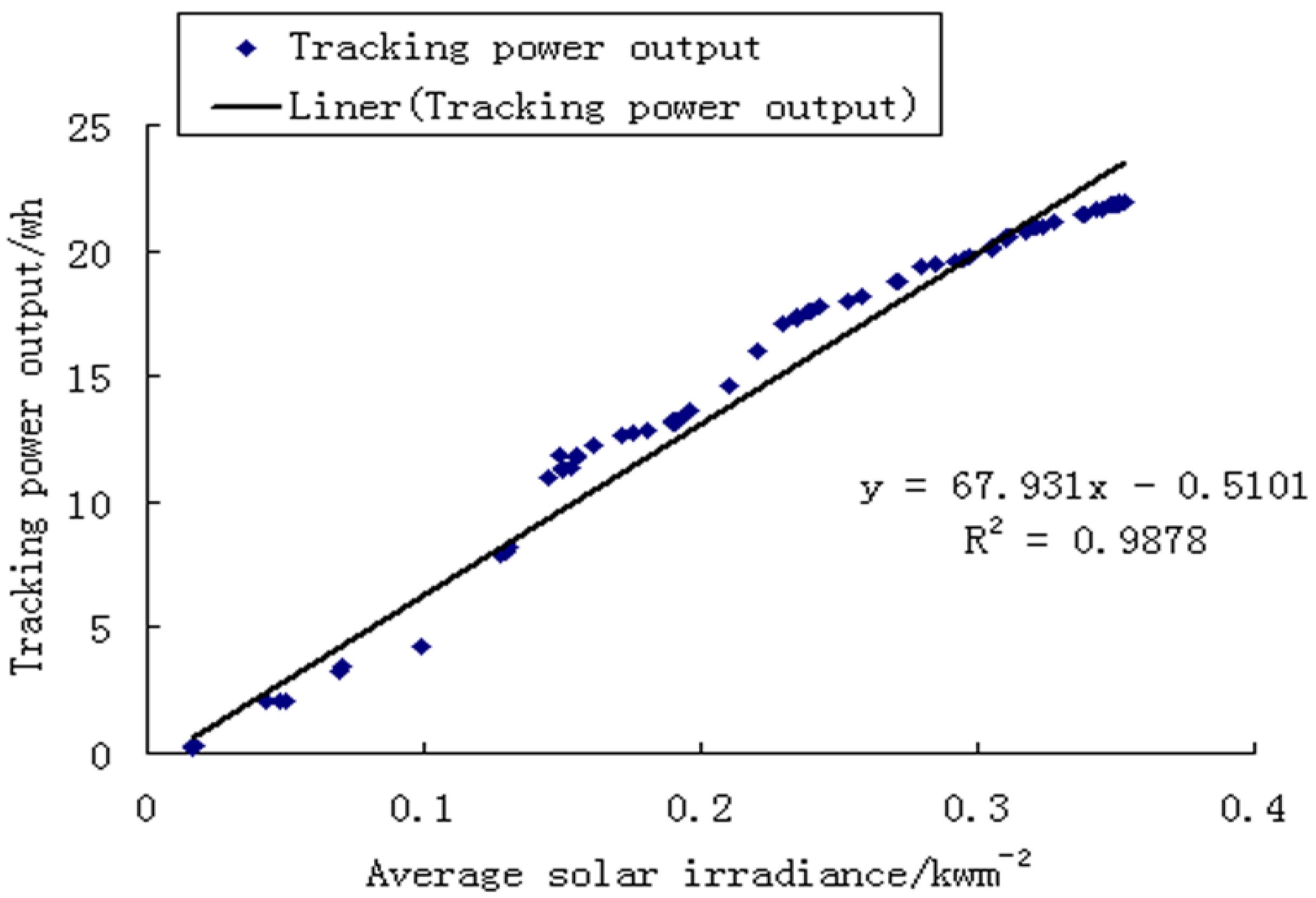
3. Material and Methods
3.1. Solar Tracking System Design
- (1)
- Structure of the automatic solar tracking system
- (a)
- Component strength: Component should have sufficient strength; the so-called strength is defined as the ability to resist damage under load.
- (b)
- Component stiffness: Component should have sufficient rigidity. Certain structural deformations cannot exceed the permissible limits of normal operation.
- (c)
- Component stability: Member should have sufficient stability; the requirements of the original straight shape remain unchanged.
- (d)
- Angle range: In the mechanical transmission part of the solar tracking system, the orientation axis angle should be at least 270°, and the corner of the pitch axis should be 90°.
- (e)
- Tracking accuracy: At a 12° angle, the system followed the sun once in every forty-eight minutes.
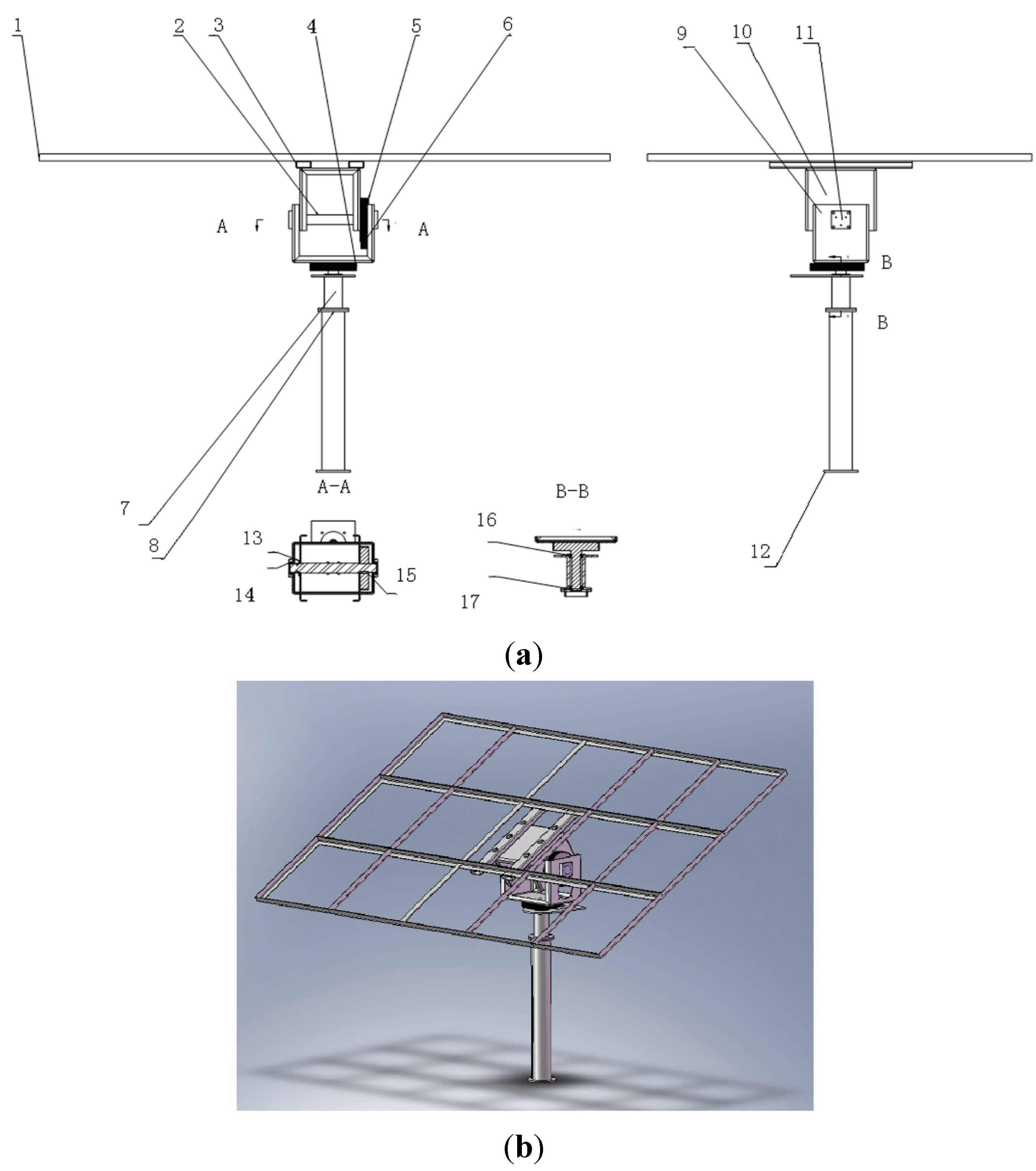
- (2)
- Motion Simulation using COSMOS Motion Analysis
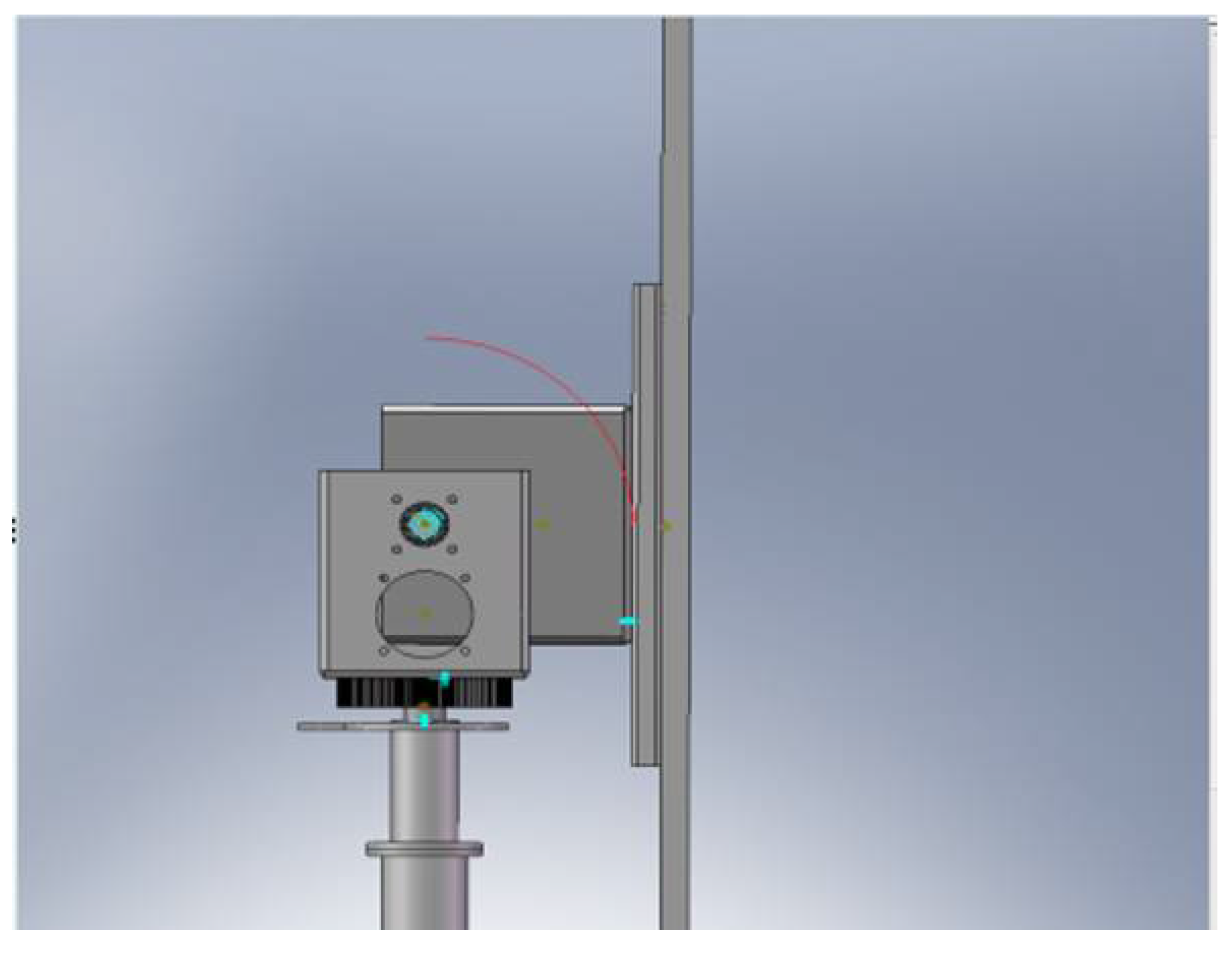
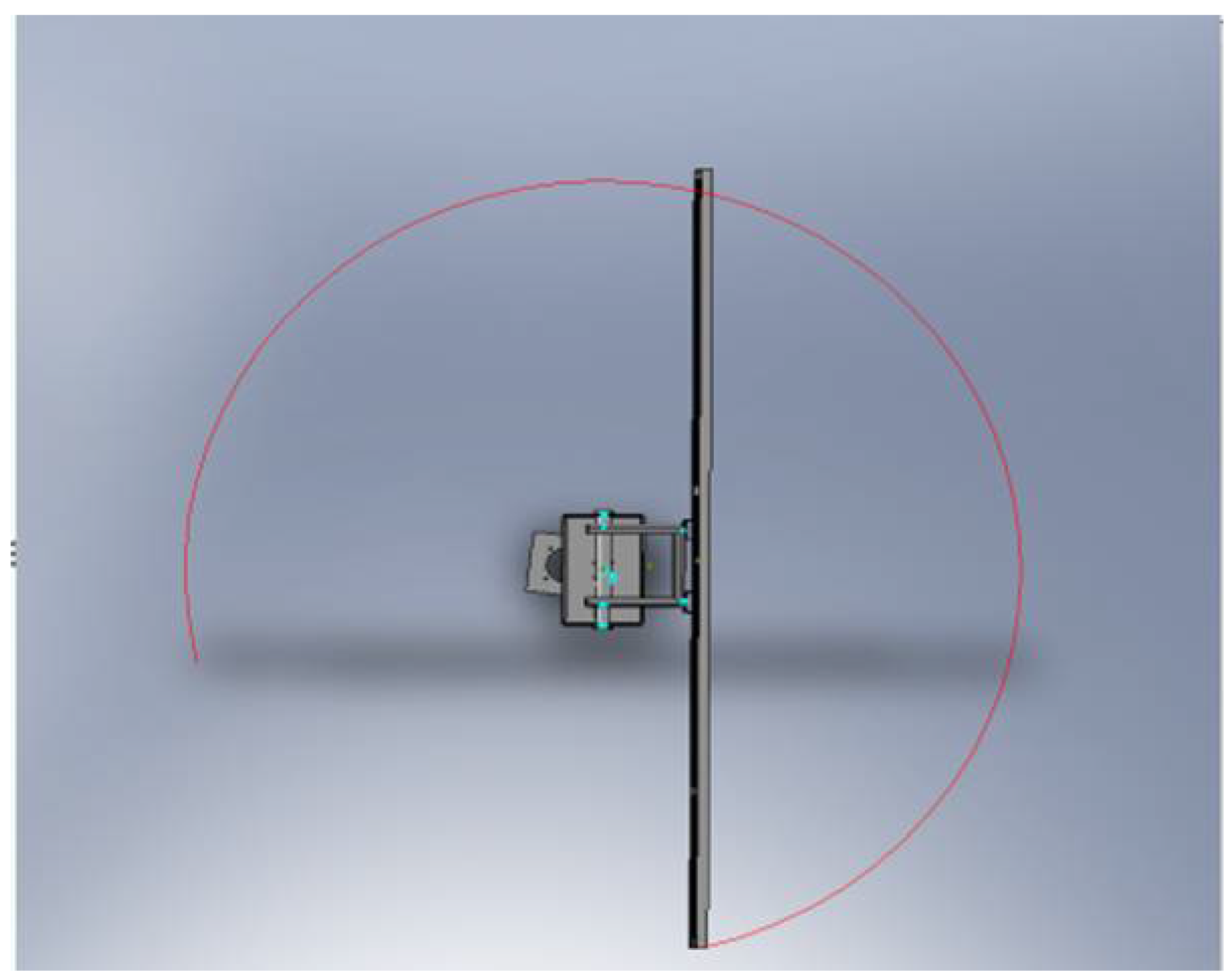
3.2. Solar Tracking System: Experimental Methods
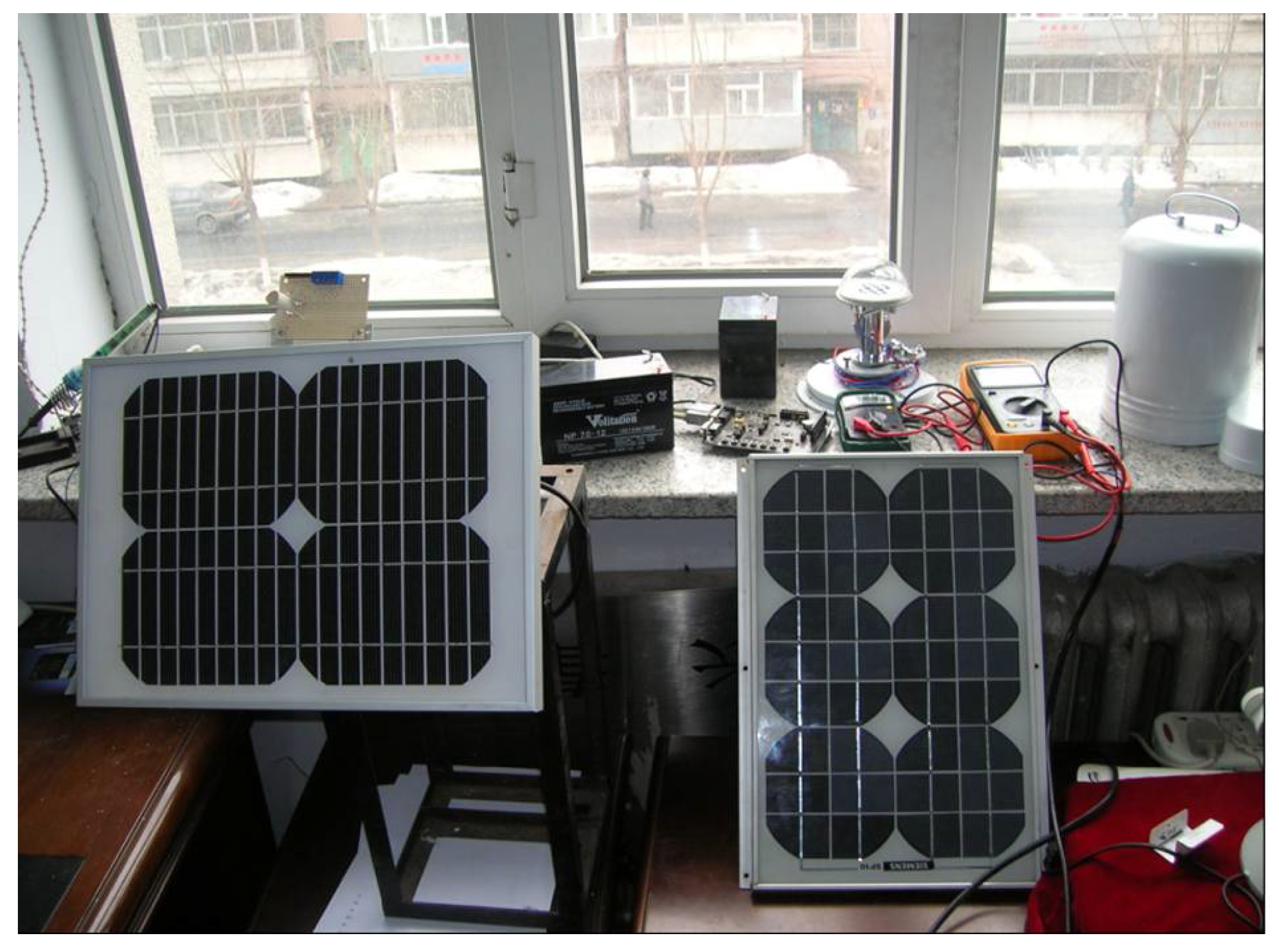
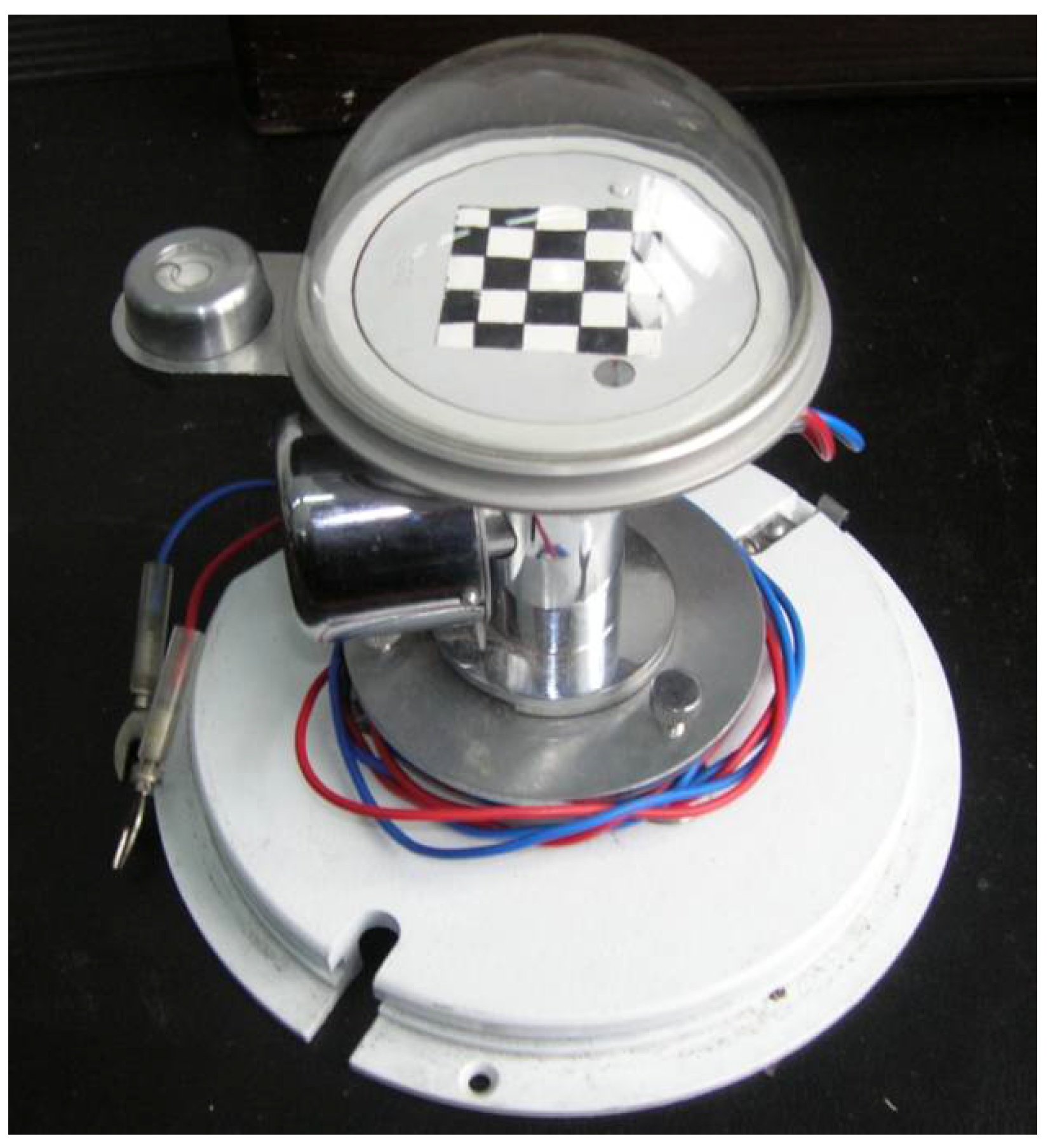
| Maximum Power | Operating Voltage | Operating Current | Open Circuit Voltage | Open Circuit Current | Dimensions | Weight |
|---|---|---|---|---|---|---|
| 10 W | 17.2 V | 0.59 A | 21.3 V | 0.63 A | 385 × 290 × 25 mm | 1.4 kg |
| Sensitivity | Resistance | Inertia |
|---|---|---|
| 7.2–14.3 μv/wm−2 | 35 ± 5 | 40 s |
| Temperature | Relative Humidity | Dimensions | Weight |
|---|---|---|---|
| −45–+45 °C | ≤95% rh | 180 × 270 mm | 3.2 kg |
4. Conclusions
- (1)
- A new solar tracking system was designed using COSMOS Motion, which performed a simulation analysis and demonstrated the expected motion trail in the absence of an interference phenomenon.
- (2)
- In this study, we successfully implemented a tracking solar power system. In northeast China, during the winter season, the days are relatively short. As a result, northeast China receives sunlight for a shorter duration of time. Therefore, very little power is generated by fixed solar panels during winter. However, with the newly designed solar auto tracking system, the power generation increased by 20% to 25% in winter. This novel system produced power rapidly and effectively.
- (3)
- A regression analysis was conducted to assess the power produced by the solar auto tracking system and fixed solar panels. The experimental results showed a positive relationship between the power generated by both the methods and the amount of solar irradiance. The higher ratio of power generated by both the solar methods was also positively associated with the average solar irradiance. The results of this study would serve to enhance solar power research throughout China.
Acknowledgments
Author Contributions
Conflicts of Interest
References
- Kolokotsa, D.; Saridakis, G.; Dalamagkidis, K.; Dolianitis, S.; Kaliakatsos, I. Development of an intelligent indoor environment and energy management system for greenhouses. Energy Convers. Manag. 2010, 51, 155–168. [Google Scholar] [CrossRef]
- Goto, E.; Takakura, T. The Effect of Artificial light on the Growth of Lettuce. Acta Hortic. 1988, 20, 313–318. [Google Scholar]
- Hu, Y.G.; Li, P.P.; Deng, Q.A.; Mao, H.P. Study on the Effect of Artificial Lighting in Greenhouse and Disposition Design of Light Source. J. Jiangsu Univ. Sci. Technol. 2001, 22, 37–40. [Google Scholar]
- Barghini, A.; de Medeiros, B.A. Artificial lighting as a vector attractant and cause of disease diffusion. Environ. Health Perspect. 2010, 118, 1503–1506. [Google Scholar] [CrossRef] [PubMed]
- Pode, R. Addressing India’s energy security and options for decreasing energy dependency. Renew. Sustain. Energy Rev. 2010, 14, 3014–3022. [Google Scholar] [CrossRef]
- Chao, R.M.; Ko, S.H.; Pai, F.S.; Lin, I.H.; Chang, C.C. Evaluation of a photovoltaic energy mechatronics system with a built-in quadratic maximum power point tracking algorithm. Sol. Energy 2009, 83, 2177–2185. [Google Scholar] [CrossRef]
- Riyad, A.M.; Salah, A.; Iyad, M.M. Design, construction and operation of spherical solar cooker with automatic sun tracking system. Energy Convers. Manag. 2011, 5, 615–620. [Google Scholar]
- Crockett, R.G.; Newborough, M.; Highgate, D.J. Electrolyser-based energy management: A means for optimising the exploitation of variable renewable-energy resources in stand-alone applications. Sol. Energy 1997, 6, 293–302. [Google Scholar] [CrossRef]
- Kelly, N.A.; Gibson, T.L. Improved photovoltaic energy output for cloudy conditions with a solar tracking system. Sol. Energy 2009, 83, 2092–2102. [Google Scholar] [CrossRef]
- McConnell, I.; Li, G.; Brudvig, G.W. Energy conversion in natural and artificial photosynthesis. Chem. Biol. 2010, 17, 434–447. [Google Scholar] [CrossRef] [PubMed]
- Li, Z.S.; Zhang, G.Q.; Li, D.M.; Zhou, J.; Li, L.J.; Li, L.X. Application and development of solar energy in building industry and its prospects in China. Energy Policy 2007, 4, 1–7. [Google Scholar] [CrossRef]
- Zhai, X.Q.; Wang, R.Z. Experiences on solar heating and cooling in China. Renew. Sustain. Energy Rev. 2008, 12, 1110–1128. [Google Scholar] [CrossRef]
- Kalogirou, S.A.; Tripanagnostopoulos, Y. Industrial application of PV/T solar energy systems. Appl. Therm. Eng. 2007, 27, 8–9. [Google Scholar] [CrossRef]
- Arbab, H.; Jazi, B.; Rezagholizadeh, M. A computer tracking system of solar dish with two-axis degree freedoms based on picture processing of bar shadow. Renew. Energy 2009, 34, 1114–1118. [Google Scholar] [CrossRef]
- Zahr, M.; Friedrich, D.; Kloth, T.Y. Bionic Photovoltaic Panels Bio-Inspired by Green Leaves. J. Bionic Eng. 2010, 7, 284–293. [Google Scholar] [CrossRef]
- Ghosh, H.R.; Bhowmik, N.C.; Hussain, M. Determining seasonal optimum tilt angles, solar radiations on variously oriented, single and double axis tracking surfaces at Dhaka. Renew. Energy 2010, 35, 1292–1297. [Google Scholar] [CrossRef]
- Zhang, Q.X.; Yu, H.Y. Simulation analysis of the security of transmission mechanism of automatic. J. Jilin Univ. 2010, 40, 480–484. [Google Scholar]
- Mohammad, N.; Karim, T. Design and Implementation of Hybrid Automatic Solar-Tracking System. J. Sol. Energy 2013, 135, 1–6. [Google Scholar] [CrossRef]
- Lee, Y.P.; Chen, H.S.; Gau, Y.Q. Analysis and Design of a Single-Axis Automatic Solar Tracking and Power Filtering System for Solar Power Generation. Sens. Lett. 2012, 10, 1075–1080. [Google Scholar] [CrossRef]
- Shiau, J.-K.; Lee, M.-Y.; Wei, Y.-C. Circuit Simulation for Solar Power Maximum Power Point Tracking with Different Buck-Boost Converter Topologies. Energies 2014, 7, 5027–5046. [Google Scholar] [CrossRef]
- Frydrychowicz-Jastrzebska, G.; Bugala, A. Modeling the Distribution of Solar Radiation on a Two-Axis Tracking Plane for Photovoltaic Conversion. Energies 2015, 8, 1025–1041. [Google Scholar] [CrossRef]
- Al-Soud, M.S.; Essam, A.; Ali, A.; Salah, A.; Hraysha, E.S. A parabolic solar cooker with automatic two axes sun tracking system. Appl. Energy 2010, 87, 463–470. [Google Scholar] [CrossRef]
- Mousazadeh, H.; Keyhani, A.; Javadi, A.; Mobli, H.; Abrinia, K.; Sharifi, A. A review of principle and sun-tracking methods for maximizing solar systems output. Renew. Sustain. Energy Rev. 2009, 13, 1800–1818. [Google Scholar] [CrossRef]
- Xue, X.D.; Zheng, H.F.; He, K.Y.; Chen, Z.L.; Tao, T.; Xie, G. Experimental study on a new solar boiling water system with holistic track solar funnel concentrator. Energy 2010, 35, 692–697. [Google Scholar]
- Zhang, Q.X.; Yu, H.Y. Analysis of statics of solar auto-tracking system and simulation of fluctuating wind. Trans. CSAE 2010, 26, 137–141. [Google Scholar]
- Zhang, Q.X.; Yu, H.Y.; Yang, D. Analysis of Solar Auto-tracking System Kinematics and Static Force. In Proceedings of the Second International Conference on Modeling, Simulation and Visualization Methods, Sanya, China, 15–16 May 2010; pp. 226–228.
- Iqbal, M. An Introduction to Solar Radiation; Academic Press: Orlando, FL, USA, 1983. [Google Scholar]
- Myers, D.R.; Stoffel, T.L.; Reda, R.; Wilcox, S.M.; Andreas, A.M. Recent progress in reducing the uncertainty in and improving pyranometer calibrations. Trans. ASME 2002, 124, 44–50. [Google Scholar] [CrossRef]
- Myers, D.R. Solar radiation and measurements for renewable energy applications; data and model uncertainty. Energy 2005, 30, 1517–1531. [Google Scholar] [CrossRef]
© 2015 by the authors; licensee MDPI, Basel, Switzerland. This article is an open access article distributed under the terms and conditions of the Creative Commons Attribution license (http://creativecommons.org/licenses/by/4.0/).
Share and Cite
Zhang, Q.-X.; Yu, H.-Y.; Zhang, Q.-Y.; Zhang, Z.-Y.; Shao, C.-H.; Yang, D. A Solar Automatic Tracking System that Generates Power for Lighting Greenhouses. Energies 2015, 8, 7367-7380. https://doi.org/10.3390/en8077367
Zhang Q-X, Yu H-Y, Zhang Q-Y, Zhang Z-Y, Shao C-H, Yang D. A Solar Automatic Tracking System that Generates Power for Lighting Greenhouses. Energies. 2015; 8(7):7367-7380. https://doi.org/10.3390/en8077367
Chicago/Turabian StyleZhang, Qi-Xun, Hai-Ye Yu, Qiu-Yuan Zhang, Zhong-Yuan Zhang, Cheng-Hui Shao, and Di Yang. 2015. "A Solar Automatic Tracking System that Generates Power for Lighting Greenhouses" Energies 8, no. 7: 7367-7380. https://doi.org/10.3390/en8077367
APA StyleZhang, Q.-X., Yu, H.-Y., Zhang, Q.-Y., Zhang, Z.-Y., Shao, C.-H., & Yang, D. (2015). A Solar Automatic Tracking System that Generates Power for Lighting Greenhouses. Energies, 8(7), 7367-7380. https://doi.org/10.3390/en8077367





